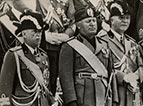Build Up to War
Firmly bound together through the inner unity of their ideologies and the comprehensive solidarity of their interests, the German and the Italian people are determined also in future to stand side by side and to strive with united effort for the securing of their Lebensraum [living space] and the maintenance of peace. In this way, prescribed for them by history, Germany and Italy wish, in a world of unrest and disintegration, to carry out the assignment of making safe the foundations of European culture.
An excerpt from the Pact of Steel, May 22, 1939
The causes of World War II stem mostly from the outcome of the Great War. The Treaty of Versailles forced Germany to accept responsibility for World War I. Germany agreed to pay large reparations to the Allies, to have its borders shrink and to lose all of its African colonies. This treaty also forbade Germany from rebuilding its military.
However, by the early 1920s, Germany had begun to default on its payments. Its citizens faced a great deal of economic hardship. The country began to rearm itself.
After the Nazis came to power in 1933, Adolf Hitler, Germany’s fascist dictator, wanted to regain the territory Germany had lost in both Europe and Africa as a result of World War I. He also wanted to seize new territories and create a German Empire. In 1938, Austria was annexed to Germany. On September 1, 1939, Germany invaded Poland. As a result, France, Great Britain and the Commonwealth countries declared war against Germany.
In May 1939, Italy and Germany signed a treaty known as the Pact of Steel. Both powers agreed to come to each other’s aid in the event of war. Yet, in September 1939, Italy resisted joining Germany. Mussolini felt he needed more time to prepare the military, the economy and the Italian people themselves for a European conflict. With France on the verge of defeat, on June 10, 1940, Mussolini joined the war on the side of Germany. He believed that the war would end quickly and that Germany would win.



